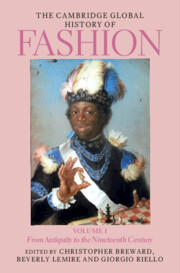Book contents
- The Cambridge Global History of Fashion
- The Cambridge Global History of Fashion
- The Cambridge Global History of Fashion
- Copyright page
- Contents for Volume I
- Figures for Volume I
- Maps for Volume I
- Table for Volume I
- Contributors for Volume I
- Preface
- 1 Global History in the History of Fashion
- Part I Multiple Origins of Fashion
- 2 Towards a History of Fashion Without Origins
- 3 Fashion in the Ancient World
- 4 Fashion on the Silk Roads, 500–1300
- 5 Distinguishing Oneself
- 6 The Material Regulation of Fashion
- Part II Early Modern Global Entanglements
- Part III Many Worlds of Fashion
- Index
- References
5 - Distinguishing Oneself
The European Medieval Wardrobe
from Part I - Multiple Origins of Fashion
Published online by Cambridge University Press: 04 August 2023
- The Cambridge Global History of Fashion
- The Cambridge Global History of Fashion
- The Cambridge Global History of Fashion
- Copyright page
- Contents for Volume I
- Figures for Volume I
- Maps for Volume I
- Table for Volume I
- Contributors for Volume I
- Preface
- 1 Global History in the History of Fashion
- Part I Multiple Origins of Fashion
- 2 Towards a History of Fashion Without Origins
- 3 Fashion in the Ancient World
- 4 Fashion on the Silk Roads, 500–1300
- 5 Distinguishing Oneself
- 6 The Material Regulation of Fashion
- Part II Early Modern Global Entanglements
- Part III Many Worlds of Fashion
- Index
- References
Summary
A garment covers, decorates, and renders its wearer distinct. This chapter focuses on this last function of clothing: distinction. I reflect on this characteristic by analysing changes in wardrobes of men and women during the European middle ages and the early modern period. I concentrate on the fourteenth to sixteenth centuries, a period in which some sort of ‘philosophy’ of distinction – based on garments and accessories – affirmed itself. Yet this chapter highlights the existence of at least four different types of distinction: it starts with social distinction, perhaps the best-known meaning of the term; it continues with a consideration of distinction as applied to the body; and follows with a consideration of geographical distinction; the final part reflects on another well-known meaning of distinction that is still with us today – dress as a form of economic distinction.1
- Type
- Chapter
- Information
- The Cambridge Global History of FashionFrom Antiquity to the Nineteenth Century, pp. 109 - 147Publisher: Cambridge University PressPrint publication year: 2023



